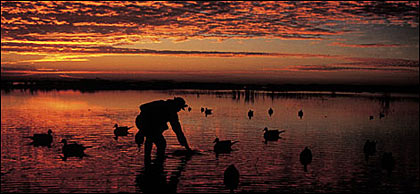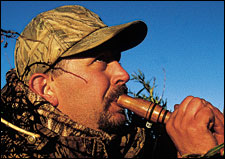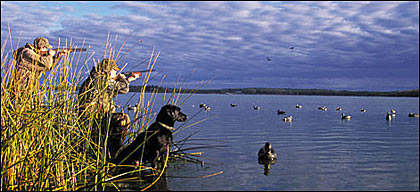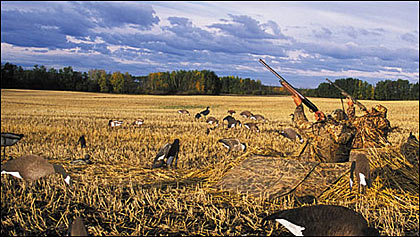November 03, 2010
By Gary Kramer
With the help of a couple of outfitters, Alberta provided a mixed bag of geese, and a variety of ducks.
By Gary Kramer
 The reward for setting up decoys before the break of dawn. A hunter retrieves ducks at sunrise. |
In the pre-dawn darkness, I could barely make out the dark silhouettes of the goose decoys pointing obediently into the wind. They too seemed to be waiting for dawn when the Canada geese would rise off a nearby lake and head to the harvested pea and wheat fields ripe with waste grain. While we were placing the last decoys, a vanguard group of mallards appeared out of the darkness and buzzed the decoys. Moments later a trio of Canada geese landed on the edge of the spread and immediately began feeding. A few minutes later when something didnÂ't seem quite right, they spooked.
Shooting time was 7:05 a.m. and we were in the willow blinds when I heard the distant chatter of geese. Our guides, Kyle Green and Seth Mann, yelled, Â"Get ready,Â" and went to work on their goose calls. A series of staccato notes and expert flagging kept the birds locked on the decoy spread with the two-way conversation at a fevered pitch until the birds were almost in range. As the birds approached, my hunting partner Fritz Reid and I sank lower in the blind, gripping our shotguns in anticipation of the impending action. The birds kept coming, their flight powerful and direct until just outside the decoys when the first dozen birds put on the brakes and decided to land. Kyle said, Â"Take Â'em,Â" and I stood up to four CanadaÂ's about to land and eight more suspended over the decoys with another 20 right behind. I picked a goose less than 20 yards away, blocked out the backpedaling bird and pulled the trigger — the goose dropped out of the sky. Looking for a double, I switched targets, pulled the trigger and missed. There were five shooters in our group and we managed to drop seven birds — not a bad way to start the day.
Advertisement
As the next flock morphed from a dark mass in the pre-dawn sky, we realized the geese numbered well into the 50s. Unfortunately they passed well out of range, even though both Kyle and SethÂ's calling were first class. Then as if acting on some unknown signal, a second flock dropped altitude and came to the decoys. I peaked toward the rising sun to see a flock of geese dropping altitude and committing to the spread. My initial estimate of 20 birds changed to three-dozen as the flock made a tight circle into the wind, wings cupped and feet down. When they were 20 yards up, Kyle yelled, Â"Take Â'em,Â" and five shooters fired at the birds that were doing their best to vacate the area. I swung right, selecting a close-in target while my hunting partner Fritz Reid tracked left. When the smoke cleared a trio of big Canada geese were lying directly in front of us. The other shooters fared equally as well and together we put nine geese on the ground.
 A little hard work can go a long way. A hunter calls geese. |
A BREEDING GROUND FOR GREAT WATERFOWLING
The action described above took place last fall near Peace River, Alberta, where tens of thousands of Canada geese spend a few weeks each fall before heading south to the wintering grounds. This region is one of the most northern agricultural areas in Canada and as a result waterfowl fresh from the breeding grounds get their first taste of grain here. The Peace River country, extending roughly in a 60-mile swath from Peace River to Manning, is a vast area of parklands and spruce forests interspersed with rivers, lakes and potholes. Even though much of Canada experienced drought conditions in 2002, the Peace River country, while dryer than normal, did not experience the extremely dry conditions that prevailed across southern Alberta.
Advertisement
The combination of food resources in the form of wheat, barely and peas attract awesome concentrations of both local Canada geese and migrants from the Arctic. The harvest is dominated by big western Canada geese that weigh from eight to10 pounds and the smaller lesser CanadaÂ's that weigh four to six pounds. Along with the geese, are impressive populations of ducks — mostly mallards and pintail with a healthy smattering of other species, including green-winged teal, gadwall, wigeon, scaup and goldeneyes. The season is September 1 to mid-December, with September and October being prime time. Early in the season, local Canada geese and ducks are abundant and quick to decoy. By mid-September, migrants arrive and waterfowl populations increase significantly. By early October the birds get restless and start to head south. Our host, Garry Checknita of Goose Master Guide Service, offers hunts until October 31, with the last weeks excellent for northern mallards and big CanadaÂ's, even though the total number of waterfowl has declined. Last season, daily limits were eight geese and eight ducks.
After the morning shoot we returned to Goose MasterÂ's 3,000-foot lodge west of Peace River. The well-appointed lodge is in its second year of operation and has a dining/lounge area and six double-rooms, each with its own bathroom. Like most hunters, we flew to Edmonton and rented a car, and then we made the five-hour drive to Peace River. Alternately, there are commuter flights from Edmonton. After a lunch that included goose stroganoff, fresh bread and vegetables, we headed to a nearby lake. Goose Master maintains two 16-foot flat-bottom boats with Go-Devil motors, which makes access to the often-shallow lakes and potholes possible. Once the boat was launched, it was a 10-minute ride to an area where Seth had seen a good concentration of ducks a few days earlier. As we rounded a bend and headed toward the point, more than 200 birds flushed from the area we intended to hunt. Wasting no time, the two-dozen decoys were out in short order and we stood knee-deep in the bulrush waiting for the birds to return.
We didnÂ't have long to wait. Fritz was first to spot a pair of mallards heading our way. Highball calls, followed by a series of feeding chuckles brought the birds to the decoys and when Fritz said, Â"Now,Â" we each picked a bird and squeezed the trigger. Both ducks fell stone dead in the decoys, and FritzÂ's Lab, Mattie, was on them instantly. Before she had time to retrieve the second bird, a trio of wigeon showed up. At first we were concerned that Mattie, now in the middle of a retrieve, would spook the incoming birds. However, it didnÂ't seem to make any difference and the wigeon maintained their flight path bringing them over the decoys at 25 yards. Fritz and I emptied our over/unders, dropping two birds. The afternoon continued at a steady pace and we ended up with two limits — mallards, wigeon, green-winged teal, scaup and a couple of goldeneye.
At Goose Master, we enjoyed three days of excellent field-goose hunting from stand-up blinds covered with willow branches or layout blinds, along with mix
ed-bag duck hunting over water. Then we headed south to Tofield, just over an hour drive east of Edmonton, and specifically to Black Dog Outfitters for the second leg of our Alberta sampler. Black Dog Outfitters (www.blackdogoutfitters.ca) is run by former Ducks Unlimited biologist Blaine Burns. Blaine has 17 years of experience in wetlands and waterfowl management in the Canadian prairies. Six years ago he gave up his DU job and went into the outfitting business full time.
The operation is located seven miles north of Tofield and hunters are housed in a five-year-old lodge with two to a room and a shared bathroom. The surrounding farmland is devoted to small grains interspersed with lakes, small wetlands and hardwood forests. Several large lakes form the cornerstone of the habitat base and are recognized as important staging areas for waterfowl. As most hunters realize, 2002 was a dry year throughout the Canadian prairies. The Tofield area was no exception, with several of the large lakes about half their normal size. Furthermore, most of the potholes were dry, even some of the larger ones.
 Having a retriever can be an enormous advantage while shooting. This Lab waits for instructions from his master. |
The dry conditions made finding a hunting location more difficult than in previous years, but when a concentration of birds was found the shooting was good. Our best field-shoot took place one afternoon in a pea field less than 20 minutes from Tofield. It was a gray afternoon threatening rain as we pulled into the field and began setting up six-dozen Canada goose decoys along with a like number of mallard field decoys. Five layout blinds were set toward the top of the spread then camouflaged with pea vines. Our guide, Boyd King, added two Roto duck decoys to the spread and we settled in to wait for the birds to arrive.
Fifty mallards were spotted in the distance heading our way and Boyd switched on the Roto ducks and began calling. More than 100 yards from the decoys, the flock dropped altitude then followed the contour of the slightly undulating ground like a terrain-following missile. Within seconds they were over the spread — some birds were suspended over the decoys, a few were landing among the look-a-like imposters and some were still on their way.
I gripped my over/under, ready for the command, and when Boyd said, Â"Take Â'em,Â" all five shooters rose, shotguns roared and birds started falling from the sky. I picked a bird low over the decoys, dropped it, and then picked a second bird. But before I could pull the trigger it was wacked by another shooter. We quickly gathered up the ducks and the count for five guns was two pintail and eight mallards. We were barely settled in our blinds when another squadron of ducks appeared heading from the same direction. Even before they made it half way to the decoys another group of birds materialized behind them. The first group decided to circle before coming in. They made two passes and by the time they were committed to the decoys the second group caught up with them.
I peaked over the edge of the layout blind to one of the most exhilarating sights a waterfowl hunter can witness — a whirling vortex of ducks numbering more than 100! Boyd said, Â"Now,Â" and I sat up to more birds inside 25 yards than I have ever seen in a field-hunting situation. I was on the far left end of the blinds and managed a double; Fritz was next to me and anchored two mallards as well. The total for the group was nine birds. Not bad, considering a couple of the hunters were not accustomed to using layout blinds and shooting from the sitting position.
The afternoon cleared slightly and the sun, still covered by a layer of clouds, brightened the sky so much that I decided to make an attempt at photographing the action. I traded my shotgun for my camera and set up a layout blind behind the shooters. For the next hour, a dozen flocks of ducks numbering from 10 to 200 came to the decoys. It was one of those situations where the ducks wanted to be in that particular field to feed and even our shooting couldnÂ't keep them out. Only an hour into the hunt, we counted the birds and found that we needed only two more ducks to fill out our eight-bird limits. It didnÂ't take long to drop the last two. There was at least another hour of daylight left when the last decoy was picked up and birds were landing only 150 yards away.
 Proper concealment, among other strategies, will help you get your limit. |
Back at the lodge that night we toasted the great shoot with a bottle of California Merlot we brought along for the occasion and enjoyed a sumptuous dinner of roast beef, potatoes and all the trimmings. After dinner we discussed the options for the next day — field-duck hunting, field-goose hunting, pothole puddle-duck hunting or hunting divers on a large lake. For a change of pace I teamed up with Jim Kurtzman, one of the other guests, to give diver hunting a try.
Cooking Lake is a large body of water near Tofield. Each fall it becomes a staging area for an impressive number of lesser scaup or bluebills, as they are often called. They assemble here as well as other large lakes in Alberta to feast on pondweeds before heading south for the winter. It was on Cooking Lake that we launched the boat at sunrise and motored 20 minutes to a point of land that formed the tip of just one of many coves on the lake. We set out four-dozen decoys — a mixture of scaup and mallard blocks in a rough hook pattern just outside a stand of bulrush. While we were setting up the decoys, several groups of scaup were already moving offshore and it took less than 10 minutes for the first passing flock to spot our decoys. They made a wide pass banking into the wind and we thought all 20 birds were ours. Just before they were ready to make the final commitment to the decoys most of them veered off and headed for some distant location. Three birds remained locked on the spread and as divers often do they came straight in only a few feet above the water. Jim picked the lead drake and fired while I picked the trailing bird. Jim connected and the drake bluebill cartwheeled across the water. I couldnÂ't believe I missed both shots, but the tell tale shot patterns let me know I was behind the birds both times. Jim sent his Lab to retrieve and the first scaup of the day was in hand.
Next to decoy was a group of six that came in high from the center of the lake then caught sight of the spread and came all the way to offer classic Â"divers over decoysÂ" action. We dropped three birds and I felt better about my shooting ability. The morning continued at a rapid pace and in less than two hours we had our eight birds each — all scaup, all shot over decoys and all retrieved by a well-trained Lab. Another enjoyable aspect of the hunt was the fact that we did not see another hunter or hear another shot on the lake all morning.
After three days with Black Dog Outfitters, we headed for the airport and I boarded an Air Canada jet bound for California. Even though IÂ've been to Alberta on numerous occasions, this particular trip provided some of the most varied action I have ever experienced anywhere. Where else can you field-duck hunt, field-goose hunt, pothole puddle-duck hunt and hunt big-water divers all on the same trip?
TRAVEL INFORMATION |
|---|
To book waterfowl hunts near Peace River in north-central Alberta contact Goose Master, P.O. Box 6913, Peace River, Alberta, Canada T8S 1S7; (866) 430-5487 or (780) 332-1839, website www.goosemaster.com. To book hunts near Tofield contact Black Dog Outfitters, P.O. Box 514, Tofield, Alberta, Canada T0B 4J0, Tel. (780) 662-3436, website: www.blackdogoutfitters.ca. For general travel information contact Travel Alberta, (800) 661-8888, website: www.travelalberta.com.
Nonresidents traveling to Canada with firearms are required to present a Firearms Declaration Form (JUS 909 EF) at Customs. The document is available by calling (800) 731-4000 or by downloading a copy from the Canadian Firearms Center website at www.cfc.gc.ca.
They also are available from Canadian Customs upon entering the country, but you will save time if you already have the form filled out. Three copies of the completed but unsigned documents (you can make two photocopies of the filled-out original) are required. The customs officer will verify the firearms listed and witness your signature before issuing a declaration. There is a $50 Canadian fee. The declaration acts as a temporary license and is valid for 60 days. To buy ammunition in Canada you must have a confirmed declaration.
|

